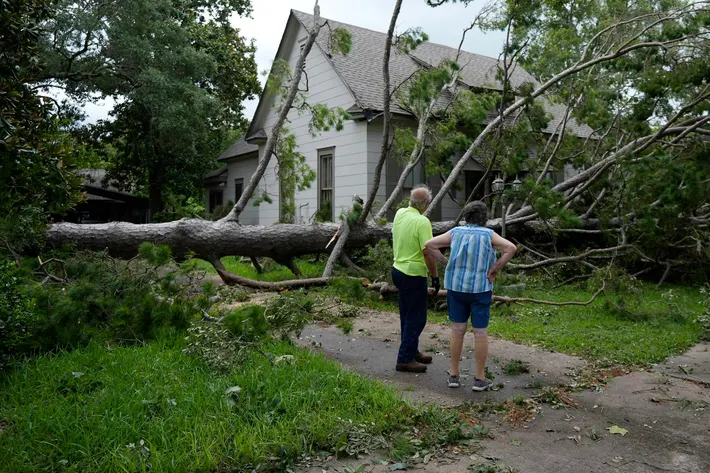At least three people have been confirmed killed after Tropical Storm Beryl made landfall in south-east Texas on Monday with howling winds and torrential rains.
According to available reports, oil ports closed as a result of the storm which also knocked out power to more than 2.5 million homes and businesses.
Before making landfall in Texas, the storm had already carved a path through the Caribbean as a category 5 hurricane, where it killed 11 people. It continued on to Mexico’s Yucatán peninsula as a category 2, temporarily dropped in intensity to a tropical storm but again strengthened to a hurricane over the weekend.
A 53-year-old man and a 74-year-old woman in the Houston area were killed on Monday in two incidents by trees that fell on their homes. A third person drowned, according to local officials.
The storm, which approached Texas with sustained winds of 75mph (120km/h), was moving north-west at 10mph and made landfall near Matagorda, a coastal town about 95 miles south of Houston, according to the US National Weather Service (NWS).
Beryl later weakened into a tropical storm and then a tropical depression, far less powerful than the category 5 behemoth that tore a deadly path of destruction through parts of Mexico and the Caribbean last weekend. But the winds and rains of the fast-moving storm were still powerful enough to knock down hundreds of trees that had already been teetering in water-saturated earth, and strand dozens of cars on flooded roadways.
Read also: EU climate service says June was 12th consecutive hottest month on record
Oil-refining activity slowed and some production sites were evacuated in the state that is the nation’s biggest producer of US oil and natural gas.
“Life-threatening storm surge and heavy rainfall is ongoing across portions of Texas. Damaging winds ongoing along the coast, with strong winds moving inland,” the NHC said even as Beryl began to lose strength.
A tornado watch was in place for an area covering more than 7 million people, according to the Storm Prediction Center. The storm is expected to weaken to a tropical storm and then to a depression as it moves inland along eastern Texas, into the Mississippi Valley and then the Ohio Valley.
“Beryl’s moving inland but this is not the end of the story yet,” said Jack Beven, a senior hurricane specialist at the National Hurricane Center.
Beryl was forecast to become a post-tropical cyclone on Tuesday and is forecast to hit Oklahoma, Arkansas and Missouri with heavy rainfall.
The storm was expected to barrel over eastern parts of Texas through the day before moving into the Lower Mississippi Valley and the Ohio Valley on Tuesday and Wednesday, the NHC said.
Following warnings that it could be a deadly storm for communities in its path, residents had rushed to board up windows and stock up on fuel and other essential supplies.
Before daybreak, strong gusts and torrential rain lashed cities and towns such as Galveston, Sargent, Lake Jackson and Freeport, television footage showed. By late morning, many fallen trees blocked roads in Houston as the worst of the storm passed, with persisting winds and some road flooding, rendering lanes on major freeways impassable. The city barricaded flooded areas.
In video posted on social media by Houston’s local ABC station, crews using a life jacket and ladder fire truck rescued a man from a truck on a flooded stretch of freeway.
Story was adapted from the Guardian.
